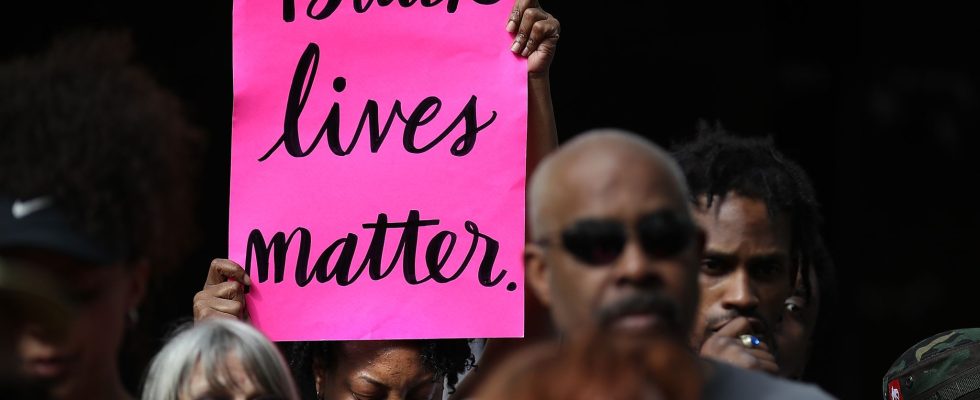“I am always surprised when I see how little black lives matter,” activist Alicia Garza wrote on Facebook on July 13, 2013 after the acquittal, in Florida, of George Zimmerman, a security guard accused of the murder of ‘a 17-year-old black teenager, Trayvon Martin. The Black Lives Matter protest movement against police violence celebrated its 10th anniversary this summer. Just published, in its final version, in the Journal of Urban Economics, a study signed by Travis Campbell, economics researcher at Southern Oregon University (SOU), highlights the impact, as undeniable as it is ambiguous, of this mobilization on public security: fewer homicides committed by police officers, but more (or even much more) homicides altogether.
To determine the evolution of these two types of homicides, the researcher first constructed a database covering nearly 1,100 cities having experienced at least one demonstration of the Black Lives Matter movement between 2014 and 2021 then he estimated , from academic and associative sources, the number of times the police used lethal use of force there. This six-year period allows it to build on one of the particularities of Black Lives Matter, which was characterized by growth in two major waves. The first, in the summer of 2014, was caused by the asphyxiation death of Eric Garner, in New York – the police officer involved was fired but not charged –, and by that of Michael Brown, in Ferguson (Missouri) – again, the officer involved was not charged. The second, much more intense in terms of demonstrations, took place in spring 2020, after the murder, in Minneapolis (Minnesota), of George Floyd – the guilty officer was sentenced to more than twenty-two years in prison. prison.
Black Lives Matter galvanized, in 2020-2021, cities that the movement had failed to raise in 2014. By comparing the crime figures, between 2014 and 2019, in the cities mobilized from the first wave and those which will only be there in the second, Travis Campbell therefore believes that he has statistically isolated the effect of the movement. Its main conclusion joins and refines that already formulated by other studies: the mobilizations around the slogan “Black Lives Matter” would have generated a 10 to 15% drop in the lethal use of force by the police, or around 200 fewer homicides committed by police officers over the years in question. Figures which mark the originality of the recent period compared to previous activist outbreaks: in the 1960s and 1970s, protest movements against police violence had, conversely, led to an increase in the number of homicides committed by police officers.
“The Ferguson Effect”
Black Lives Matter deeply divides America: today, according to a recent poll, 51% of Americans say they support the movement while 46% oppose it. Not surprising, according to the author, as the movement can both be “lauded for highlighting issues of racial justice and creating opportunities for police reform, while being criticized for its violence, the destruction of property, the demonization of the police and the increased crime that sometimes followed.” Travis Campbell’s study demonstrates the complexity of the movement and its reception to the great self-service of ideas, as well as its polarizing character. As soon as the first version of his work was published in 2021, some commentators insisted on his “optimistic” conclusion regarding the decline in homicides committed by the police, while others had focused on his other conclusion: over the same period and the same sample of cities, the number of murders increased by approximately 11.5%, or 3,000 more homicides. For each fewer homicide committed by the police, there would therefore be 15 more in general. In the summer of 2020, a study conducted by Harvard economists for the National Bureau of Economic Research had delivered a close observation based on the targeted analysis of a few cities where homicides committed by police officers had been highly publicized, such as Baltimore, Cincinnati or Ferguson.
If the link between demonstrations and an increase in crime seems a priori less direct than that between demonstrations and a reduction in the number of homicides committed by police officers, a causal mechanism can be put forward. A first explanation for the decline in the lethal use of force by police officers is the increasing equipment with intervention cameras, which has further formalized the relationships between officers and those arrested. But there is a second, which has an impact on crime in general: faced with increasing hostility from the population, the police would have reduced their interactions with them, who would have used their services less. This is what the research calls “the Ferguson effect“: a withdrawal from the field which reduces the risk of “blunders” but also reduces the intensity of police work and increases crime. The figures for attacks on property would be a symptom of this: when blood crimes, by definition the most visible, are increasing, fewer thefts and burglaries are being reported than before and the rate of clarification of these cases is falling. As if the police and victims had, on this precise point, withdrawn from the game…
At the end of Travis Campbell’s study, there remains a major question: the respective consequences of these two opposing developments. According to the researcher, compare the impact of a police homicide to that of a “classic” homicide is like statistically adding apples and oranges. In the long term, each of these crimes has different “spillover effects” on society, on those who are not direct victims, their mental health, respect for institutions and the law, and therefore the higher probability that crimes will be committed in the future. Effects which would be more significant for murders committed by police officers, but probably not, recognizes the author, to the point of erasing the disproportion of one case of less lethal use of force by an officer for 15 homicides “classic” moreover.
